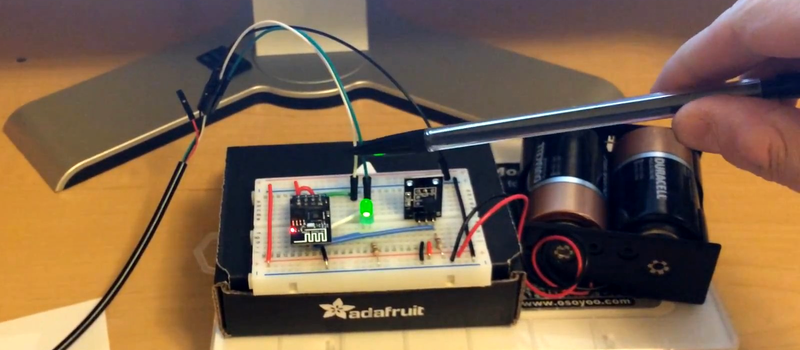Anyone keeping up with financial news today is surely inundated with stories about Bitcoin and other cryptocurrencies. While most of the news is about the potentially inflated value of some of these coins, and how drastically they have changed in price in just a decade, there are other interesting things going on behind the scenes. For example, the currency Ethereum allows for a distributed programming platform of sorts to be implemented in the blockchain, which [GusGorman402] has taken advantage of in his latest project (YouTube link, embedded below).
The device that he built is based on an ESP8266 which connects to a router running an instance of a Go Ethereum node. Essentially, he uses the Ethereum blockchain to control an LED connected to the ESP8266 using a feature of Ethereum called a smart contract. While this might be a misleading name, a smart contract is basically an autonomous program that can do virtually anything a programmer writes into it. While this is a roundabout way to write a “Hello World” program, it does demonstrate the power of the Ethereum platform when compared to other cryptocurrencies.
If you’re interested in currency trading, blockchains, cryptography, or the future of computing, be sure to check out the detailed video after the break. It’s a curious new tool, and it will be interesting to see how developers and hackers alike use it to accomplish things we’ve never thought of yet.
















Combine two buzzwords and you have a winner..
Indeed, I read the linked page, and I still have _NO CLUE_ what it’s about.
It’s just an example. Ethereum blockchain allows to post little programs (called contracts) on the distributed storage and then execute them via calling functions on them.
What he did, he wrote a contract that turns an LED on and deployed it on Ethereum network. His contraption monitors the blockchain and changes the state of the LED based on the state of the contract. Anyone in the world in theory could access that contract and tell it to turn lights on, which within 15 seconds is reflected on the LED.
As for uses of this particular contract – there are none.
Blockchain Fidget Spinner. Could also make a ‘plus’ version that uploads to the Cloud.
Distributed programs aka malware? The other worry about cryptoware is how everyone’s trying to turn your computer into a miner.
Yep, but this is a case of malware which needs to burn [some currency] to operate. So to switch this diode on and off, you must pay some amount to do it. I you know enough programming, you can connect anything with anything, so that when you open your fridge door, you can send ethereoum to release a pidgeon which upon going home will send sms message delivered to twillio that will notify your home server through rest service, which will open your window by sending some udp packet to esp32 which will send CAN message to your smart servo controlling a servo. Is it possible? Totally yes, but impressive? Just like any other Rube Goldberg machine, stops being amusing after a while.
I don’t know, I can see some applications.
A power meter for community grids that makes sure the power consumed has been paid for. Maybe a hostel where the room’s main lock unlocks only after rent has been paid. Blinking an LED is a pointless proof of concept, like programming a 64-bit quad-core ARM MCU to blink an LED when a 555 could do the same thing.
Also, malware implies something malicious is being done, and I wouldn’t consider transaction management malicious. That’s like saying the Google Wallet on your phone is malware, or your billfold is some sort of weapon.
How is this not useful? I mean if you consider IOT in general useful, this could be useful as well.
The main difference is that you don’t need a centralized server for Ethereum IOT to work.
On the flip side, everyone can see what’s going on with your garage door..
Actually, I would completely agree to mine some coins for some website’s owners I’m visiting if they would remove all the pesky screaming ads that burns my CPU anyway. I’m pretty sure they’ll make more money in the end, enough to rework their website to remove all the used ad page estate.
Could be an option – advertisements or bitmining, visitors choice.
This video uses something called a Proof of Authority network (Rinkeby), no mining involved. It is a test network, meaning the ether has no monetary value (unlike the public mainnet where miners mine and investors invest and is Proof of Work). So in the future, a company like Samsung or Honeywell will make their IoT thermostats connect to the companies’ private blockchain network instead of dialing into a central server. I doubt you’ll see many environmental sensor IoT devices on the public mainnet, but you’ll see companies forming private blockchain networks for collaboration. The Blockchain in Trucking Alliance may have their own logistics blockchain, the Trusted IoT Alliance may have their own private PoA chain also. The tech is still a lil clunky, but you can create user interfaces with HTML/JS to interact with the smart contract also. I think it’ll be an alternative to MQTT brokers
DAISEE project has more advanced examples. They are dealing with the energy grid and are also a Hackaday prize contestant
https://hackaday.io/project/10879-2016-internets-of-energy-call-me-daisee
How much detail in that “F**K NO” do you want?
Ethereum/Solidity is the single worst language and system design I have seen in the last 15 years. It seems to exist to produce schadenfreude. For example: https://blog.comae.io/the-280m-ethereums-bug-f28e5de43513
Whiner.